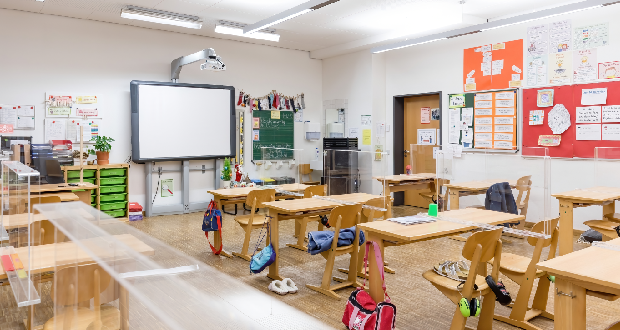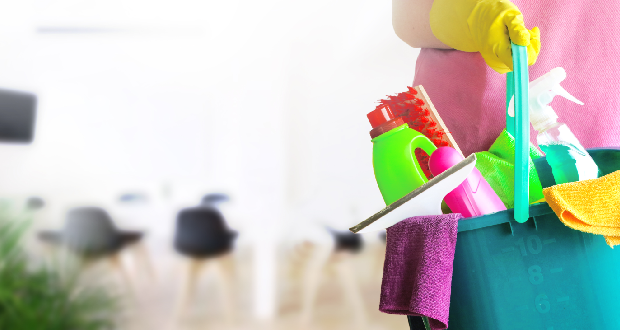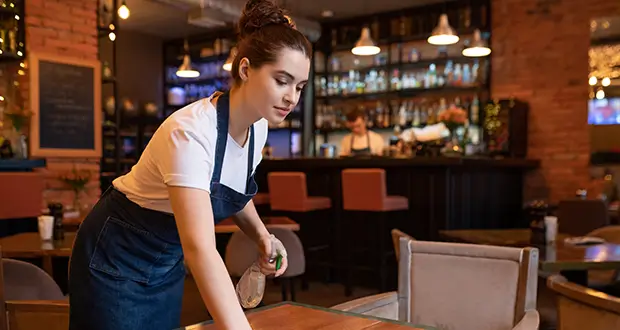
No products available in cart, click 'Go to Products Page' to add products
Go To Products PageIt is more important now than ever to have a clean and sanitized restaurant for your diners. Especially since the Covid-19, diners need reassurance that it is safe to eat in restaurants.
Effective restaurant cleaning and sanitizing are essential to the success of your business. They help maintain a positive image, reduce the risk that diners may be exposed to dangerous pathogens, and it also helps prevent cross-contamination.
There’s no right or wrong answer regarding the restaurant’s cleaning and sanitizing procedures. However, ensuring your restaurant is safe for diners and staff is fundamental.
Continue reading this article to learn how to clean and sanitize your restaurant in five easy steps. Whether you're a seasoned professional or new to the industry, following these steps will help keep your restaurant sparkling clean and safe for your diners and workers.
Several types of disinfectants are available, each with advantages and disadvantages. Here are some of the most common disinfectants:
Create or update your cleaning checklists for front- and back-of-the-house staff, and assign task items for each high-traffic surface (doors, chairs, tables, etc.), each surface that comes into contact with food, and any supplies or equipment used throughout the day.
Maintaining a daily, weekly, and monthly restaurant cleaning and sanitizing checklist can prevent the spread of diseases and guarantee a hygienic dining experience.
Choosing the right cleaning and sanitizing products is important for maintaining a clean and sanitary restaurant environment. Because using the appropriate products can effectively eliminate harmful bacteria, viruses, and other contaminants that can cause foodborne illnesses.
Always go for cleaning products specifically designed and safe to use in food service environments. These products will effectively remove grease, oil, and other food residues while being safe for use on surfaces that come into contact with food.
Work with your supplier to find the products that meet disinfection criteria and also ensure that the restaurant staff understands the usage requirements, such as:
**Thinking about purchasing restaurant cleaning products? Then invest in the “Reckitt Pro Solutions - Hospitality Bundle.” A discounted bulk purchase feature - enabling you to forget about frequent restocking and running out of critical supplies during busy periods with a constant supply of cleaning products. These savings can reduce the overall cost of cleaning and sanitizing your restaurant.**
Cleaning removes dirt, dust, and other visible contaminants from surfaces, and sanitizing reduces the number of bacteria and other harmful pathogens on surfaces.
Follow this five-step process to clean and sanitize your restaurant effectively.
Before cleaning and sanitizing, remove any food particles or other debris from the surfaces by scraping them off with a scraper, brush, paper towel, or cloth. Ensure all residue is removed from the surface before proceeding to the next step.
Wash away any leftover food residue or dirt with the help of a cleaning cloth or brush and a cleaning solution made from an antiseptic liquid. Be sure to cover all areas of the surface and pay special attention to areas that are frequently touched or come into contact with food.
Rinse off the surface thoroughly with water to remove any remaining cleaning solution.
Use disinfectant spray or liquid to reduce the remaining germs and bacteria on the surfaces. Follow the instructions on the product label to ensure you use it correctly. Leave the product on the surface for the recommended time before properly wiping it off.
Allow the surface to air dry completely before using it again. This step is important to prevent the growth of bacteria and mold, which thrive in moist environments.
The cleaning and sanitizing process is incomplete without covering both ends of the restaurants (front and back of the house).
Front-of-the-houseIf the restaurant staff isn’t practicing good hygiene, then they won’t be able to do a good job in helping the restaurant maintain cleanliness standards.
Restaurant staff can adopt the following hygiene practices to maintain a clean and sanitized restaurant, ensuring the safety and satisfaction of diners.
So there you have it. Effective cleaning and sanitizing of your restaurant using those steps are essential for building customer trust.
Keeping your restaurant clean and germ-free helps establish an atmosphere where they can relax, enjoy their food, and not worry about the public health crisis because they know you’ve got their back.
Here’s how you can implement cleaning and sanitization changes in your restaurant:
The kitchen is the most important place to clean and sanitize the restaurant. This area is exposed to various bacteria, viruses, and other harmful microorganisms that can lead to foodborne illnesses.
Some natural products like vinegar and baking soda can be used as effective cleaning agents.
Reckitt Pro Solutions represent a well-diversified portfolio of leading global brands for businesses like you to clean effectively and efficiently.






